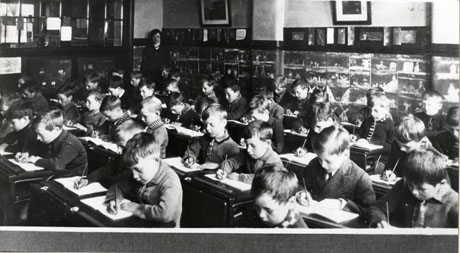Last week we painted a picture of school in stage 5 of our framework, where students are truly becoming collaborative innovators who tackle the real-world problems.
This week we present the 3 shifts schools, and in turn teachers and students, must take to get there. We’ll introduce them here today and then zoom in on each key shift as the week progresses.
1) Shift control from the adults to the students.
This means that teachers stop directing…

(photo credit: http://edtochangetheworld.com/wp-content/uploads/2013/06/d6e7c-kickingandscreamingmoviedvdreview.jpg)
And start coaching…
Although this shift happens gradually throughout our entire framework, it’s important to notice that in stage 5 control over learning has shifted almost entirely to students. Students lead their own inquiry and adults are there to support them, ask questions to push their thinking, and give feedback on their ideas.
This means a new way of thinking for teachers. We are no-longer the authority in the room, nor do we have to be. As our students investigate a water crisis in the Sudan, we can research and learn along with them. This also means flipping the way students see teachers. We can no longer be the ones who plan the learning and give the answers. Students must do that for themselves. The common refrain as students enter the room can no longer be, “What are we doing today?” When students control the learning, THEY must be the ones to plan for and monitor their own progress.
How do you start? A simple first step is to present students with a problem to solve or a learning goal to achieve and ask THEM what they will do and what resources they will need. Will they do research online? Great – you can reserve the computer lab. Will they conduct an experiment? Great – you can bring them microscopes. Don’t be afraid to let them hit dead ends! Learning to learn is a messy process.
2) Shift from individual work to collaborative inquiry.
This means less of this…

(photo credit: http://ppparchive.durham.gov.uk/images/easc0060_tcm4-14773.jpg)
And more of this…

(photo credit: http://www.scholarssecret.com/clientuploads/smaller%20new%20kids%20collaborating%20iStock_000014381969XSmall.jpg)
In stage 5, this means much more than “group work.” True collaboration means that students in a group share responsibility for the same product and strategize together in order to leverage each person’s strengths to achieve the best possible outcome. Students do not submit individual work to the teacher; they submit their individual contributions to each other for feedback and revision. Students do not receive individual grades based on their individual efforts; for one to succeed, the team must succeed, and all are accountable for the entirety of the team’s work. They do not take on rigid roles (you are the recorder, I am the illustrator) assigned by the teacher; they determine their own roles and flexibly take on new roles as needed in the project.
How do you start? One step is to give students an assignment where they must collaborate to be successful. This could be any task where the “grade” received by each student depends on the entirety of the group’s work. Perhaps it’s a class newspaper or a website for the unit you’re currently studying. Spend your time coaching students to work well together and reflect on their ability to collaborate while the students themselves worry about the product.
3) Shift from classroom exercises to real-world problems.
This means less of this…

(photo credit: http://0.tqn.com/d/math/1/0/1/C/6a.jpg)
And more of this…

(photo credit: http://www.usnews.com/pubdbimages/image/45460/FE_DA_20130314_GB_ED_ENGSTEM250x166.jpg)
If your class happens on paper inside the four walls of the school building, you’re not at stage 5. (Don’t worry – we’re still working on this ourselves!) For students to learn how to solve real-world problems, we need to give them practice solving problems in the real world, under real-world parameters, with all of the real-world ambiguities in tact. This means that each issue studied will take an extended period of time and students will have to persevere through setbacks and sustain interest and motivation through difficulties.
How do you start? First, present students with a problem. The more “real” the problem is, the better. Second, ask them to solve it. It really is that simple! Take a look at some of these resources about problem-based learning (PBL). The tough part is restraining yourself from finding the solution for them, and resisting the urge to plan how they’ll get there. Give students some space to figure it out themselves, and they will.
Which of these three shifts is toughest for teachers? Leave a comment to let us know what you think.
